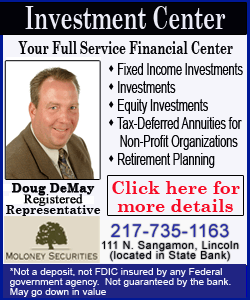|
Fed turns to Trump agenda
with rate hike nearly in the bag
 Send a link to a friend
Send a link to a friend
 [December 12, 2016]
By Howard Schneider [December 12, 2016]
By Howard Schneider
WASHINGTON
(Reuters) - The Federal Reserve inaugurates the Trump era this week with
a near-certain interest rate increase and new economic forecasts
providing a first glimpse into whether the U.S. election has reshaped
the central bank's growth and inflation outlook.
Fed fund futures show a 97 percent probability that the Fed will lift
rates by a quarter of a percentage point at the end of its two-day
policy meeting on Wednesday, according to the CME Group.
All 120 economists in a Reuters poll expect a rate hike in the wake of a
string of solid U.S. economic reports.
More telling will be whether the stock market rally and jump in bond
yields triggered by Trump's Nov. 8 victory will push the Fed to an
inflection point of its own and a higher projected pace of rate
increases for 2017 and beyond.
The Republican businessman is inheriting a good economy, one that grew
by 3.2 percent in the third quarter, the fastest pace in two years.
There are, however, concerns that his plan to reduce taxes, cut
regulation and increase infrastructure spending could not just boost the
economy but also fuel higher inflation.
Since first published in 2012, the Fed's quarterly "dot plot" of
projected interest rates has generally moved in one direction – down –
and any post-election change will show whether policymakers expect
Trump's policies to shake things up.
As of September, Fed officials' median projection was for two rate
increases next year and a long run "neutral" level of 2.6 percent. A
rate increase this week would be the first since last December and only
the second since the 2007-2009 financial crisis.
"Their path is going to move up faster and a little sooner," said Steve
Rick, chief economist for CUNA Mutual Group. He said the economy was
running at its potential, and that was the Fed's cue to "exit stage
right" and steadily move rates to normal.
Fed officials have long hoped that other government policies would take
the place of monetary engineering, which some believe may have lost its
effectiveness in lifting economic growth.
They have warned in recent weeks that any new government spending should
specifically be designed to boost productivity in an economy that is
already near full employment and facing a high public debt burden.
The Fed's new forecasts will indicate if policymakers feel that the
monetary-to-fiscal handover is on the horizon, or need more time for the
Trump administration's plans to become more detailed and move through
Congress.

Fed Chair Janet Yellen is scheduled to hold a press conference at 2:30
p.m. (1930 GMT) on Wednesday to elaborate on the economic outlook and
policy statement.
She'll have a broad set of issues to cover since her last press
conference in September - from the Federal Open Market Committee meeting
itself, to the likelihood she will be replaced in early 2018 and the
risks she foresees from the Trump agenda.
Trump repeatedly attacked Yellen during the election campaign, accusing
her of holding down rates to help his Democratic rival. Since the
election, he has expressed his disapproval of corporate America,
criticizing Boeing <BA.N>, and took credit for a deal to keep hundreds
of jobs at an Indiana plant from being moved to Mexico.
[to top of second column] |

The president-elect also will be under scrutiny after this week's Fed
meeting for clues about how he plans to handle his relationship with the
central bank.
"There is a real risk that he could be openly critical of the decision
to raise rates next week," Paul Ashworth, an economist with Capital
Economics, said in a note last week.
That could upset markets and raise serious issues about whether Trump
intends to leave the Fed alone or try to influence its decisions. Top
U.S. elected officials, in particular the president, typically avoid
criticizing the Fed's short-term rate decisions, emphasizing instead the
need for monetary policy to be set independently.
"If he remains silent after the announcement to raise interest rates
next Wednesday, then we can begin to assume that it will be business as
usual for the Fed," Ashworth wrote.

WATCHING THE MARKETS
Trump's plan to cut taxes and regulation and funnel fresh billions into
capital projects must pass Congress, and it may be well after that
before any new programs meaningfully effect economic forecasts.
But policymakers also watch the markets closely. It may be hard for the
Fed to stick with its ultra-slow pace of rate hikes if a major tax
overhaul and fiscal spending plan are unleashed.
TD Securities analysts said that fiscal policy at this point in the
economic recovery could prompt "an inflationary demand shock" that adds
nearly a percentage point to economic growth, but spurs the Fed to raise
rates much quicker than expected - by nearly an extra percentage point
per year.
That scenario of a central bank caught behind the curve and forced to
act faster is one that Yellen and other policymakers have said they hope
to avoid out of fear it could prompt a recession.
Fed officials in recent days have acknowledged the Trump agenda may
cause them to switch gears, though it is not clear how soon.
"At this juncture, it is premature to reach firm conclusions," New York
Fed President William Dudley said last week.
But, since Trump won the election, Dudley added, "the stock market has
firmed, bond yields have risen and the dollar has appreciated ... Market
participants now anticipate that fiscal policy will turn more
expansionary and that the (FOMC) will likely respond by tightening
monetary policy a bit more quickly than previously anticipated."
For a graphic on The Trump inflection, click: http://fingfx.thomsonreuters.com/gfx/rngs/USA-FED-MEETING/010030Z023W/index.html
(Reporting by Howard Schneider; Additional reporting by Ann Saphir in
San Francisco and Jonathan Spicer in New York; Editing by Paul Simao)
[© 2016 Thomson Reuters. All rights
reserved.] Copyright 2016 Reuters. All rights reserved. This material may not be published,
broadcast, rewritten or redistributed. |